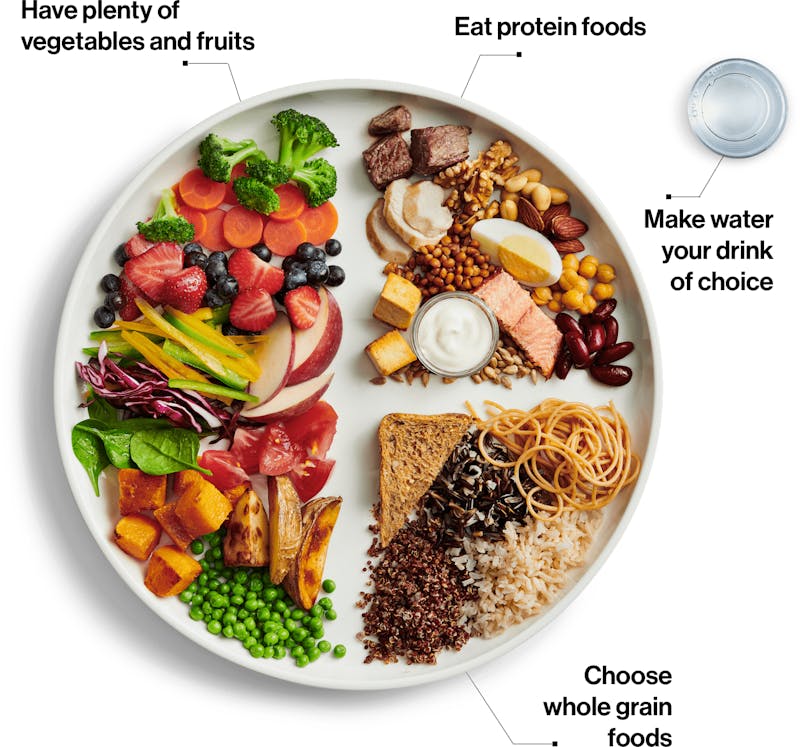The new Canada Food Guide: Once again high-carb, low-fat

The much-anticipated new Canada Food Guide has finally been released by the Canadian government. It represents a significant change — some good, some not — from the previous guide released 12 years ago.
Milk and dairy products have been down-graded and plant-based proteins promoted as equivalent to meat and other animal-sourced proteins. Fruit juice, added sugar and refined grains have been removed, but the advice to eat “plenty of whole grains” is still a dominant feature, making it, overall, a very high-carb diet. Fat is almost nowhere to be found, and that includes the virtual absence of cheese.
The release was accompanied by a flashy news conference presided over by the federal Minister of Health claiming that this was a diet that could “serve the needs of Canadians coast to coast.” The government materials note that the guide is “directed towards a healthy Canadian population so they can meet their nutrient needs and reduce their risk of obesity and chronic disease.” (More on that below.)
The government also debuted a new interactive website for the guide that features practical advice for healthy eating, demonstration videos and recipes, as well as information for health professionals and a summary of the scientific evidence that the government used to create the guide.
Government of Canada: Canada’s new food guide
Of course, the new guide is being widely covered and explained in all of Canada’s major news media, with most outlets noting what is in and what is out.
The Globe and Mail: Canada’s new food guide explained — Goodbye food groups, hello hydration
Globalnews: Canada’s new food guide trims down on dairy — should you?
First, what’s good about it?
While it still represents a high-carb, low-fat pattern of eating, the guide has made significant improvements from the previous version. Giving credit where credit is due, here’s what is good (from a low-carb perspective):
- The new plate illustration is clear, simple and easy to understand. (The old version had a “rainbow” design of four food groups that was widely derided as being incomprehensible.)
- The removal of fruit juice as a healthy fruit choice (it is really 100% sugar) is a significant advance. The guide also advises Canadians to avoid all sugary sports drinks, chocolate milk and other beverages that pack a wallop of extra sugar. Plain water is advised as the drink of choice.
- Refined and processed foods are advised to be highly limited, eaten less often and only in small amounts.
- Whole unprocessed foods are promoted.
- The plate illustration features largely low-carb vegetables, with only small amounts of fruit and starchy, higher-carb vegetables.
- The guide also notes that “healthy eating is more than the foods we eat” and advises Canadians on a large number of healthier eating habits such as cooking meals at home, eating with others, being mindful and noticing when you are hungry and full.
What’s not so good?
For anyone with metabolic issues, such as type 2 diabetes or pre-diabetes, the advice continues to promote consuming a huge amount of daily carbohydrates that will make it hard for many to keep their blood sugar under control.
Prof. Dave Harper, PhD, a keto-advocate, scientific advisor to the Canadian Clinicians for Therapeutic Nutrition and a visiting scientist at the BC Cancer Research Centre, estimates the overall macronutrient distribution of the new guide as approximately 10-15 percent of calories as protein, 15-20 percent as fat, leaving the remaining 65-75 percent of calories as carbohydrate. Harper said:
In short, it has the same problems as the last one: high-carb, low-fat. This is not supported by science.
Registered Dietitian Joy Kiddie, MSc, RD, who blogs and counsels patients in low-carb eating, notes the new food guide really only applies to a small percentage of adults of normal weight who are currently metabolically healthy. Kiddie wrote about the guide in her blog:
Based on recent data as many as 88% of adults may already be metabolically unhealthy so this advice applies to a minority of people. A diet that provides 325-375 grams of carbohydrate per day (based on a 2000 kcal per day diet) is not going to adequately address the underlying cause of metabolic issues.
Kiddie also notes that the diet appears deficient in calcium:
With both cheese and milk being limited in this new food guide, adequate calcium intake may be of concern; especially since vegetables that are high in calcium will have that calcium made unavailable to the body due to the high amounts of phytates, oxylates and lectins that are contained in the grains, nuts and seeds that are also in the diet.
The influential Food Guide is widely used by Canadian schools, hospitals, health professionals, and all government institutions to guide all nutrition advice and institutional menus.
Eating advice to Canadians first appeared in the 1940s, during war rationing, and has had many iterations over the intervening years. Like the US dietary guidelines, the Canadian guidelines in the early 1980s switched to promoting a low-fat, high-carbohydrate diet. This change directly correlates to the trajectories of the exploding epidemics of obesity and type 2 diabetes over the last four decades.
The Globe and Mail: Canada’s Food Guide through the ages
Earlier
Boring but important: Help change the dietary guidelines!
Canadian doctors rock awareness-raising about low-carb eating
Is the tide turning in Australian dietary advice?
Nina Teicholz in WSJ: “Carbs, good for you? Fat chance!”
































